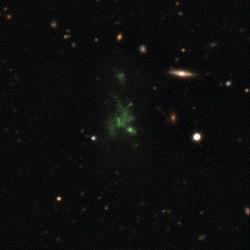
A quasar is an extremely luminous active galactic nucleus (AGN). It is sometimes known as a quasi-stellar object, abbreviated QSO. The emission from an AGN is powered by a supermassive black hole with a mass ranging from millions to tens of billions of solar masses, surrounded by a gaseous accretion disc. Gas in the disc falling towards the black hole heats up and releases energy in the form of electromagnetic radiation. The radiant energy of quasars is enormous; the most powerful quasars have luminosities thousands of times greater than that of a galaxy such as the Milky Way. Quasars are usually categorized as a subclass of the more general category of AGN. The redshifts of quasars are of cosmological origin.

The observable universe is a ball-shaped region of the universe consisting of all matter that can be observed from Earth or its space-based telescopes and exploratory probes at the present time; the electromagnetic radiation from these objects has had time to reach the Solar System and Earth since the beginning of the cosmological expansion. Initially, it was estimated that there may be 2 trillion galaxies in the observable universe. That number was reduced in 2021 to only several hundred billion based on data from New Horizons. Assuming the universe is isotropic, the distance to the edge of the observable universe is roughly the same in every direction. That is, the observable universe is a spherical region centered on the observer. Every location in the universe has its own observable universe, which may or may not overlap with the one centered on Earth.

In the fields of Big Bang theory and cosmology, reionization is the process that caused electrically neutral atoms in the universe to reionize after the lapse of the "dark ages".

In astronomical spectroscopy, the Lyman-alpha forest is a series of absorption lines in the spectra of distant galaxies and quasars arising from the Lyman-alpha electron transition of the neutral hydrogen atom. As the light travels through multiple gas clouds with different redshifts, multiple absorption lines are formed.

The Multi-Unit Spectroscopic Explorer (MUSE) is an integral field spectrograph installed at the Very Large Telescope (VLT) of the European Southern Observatory (ESO). It operates in the visible wavelength range, and combines a wide field of view with a high spatial resolution and a large simultaneous spectral range. It is specifically designed to take advantage of the improved spatial resolution provided by adaptive optics, offering diffraction-limited performance in specific configurations. MUSE had first light on the VLT’s Unit Telescope 4 (UT4) on 31 January 2014.

In astronomy, a Lyman-alpha blob (LAB) is a huge concentration of a gas emitting the Lyman-alpha emission line. LABs are some of the largest known individual objects in the Universe. Some of these gaseous structures are more than 400,000 light years across. So far they have only been found in the high-redshift universe because of the ultraviolet nature of the Lyman-alpha emission line. Since Earth's atmosphere is very effective at filtering out UV photons, the Lyman-alpha photons must be redshifted in order to be transmitted through the atmosphere.
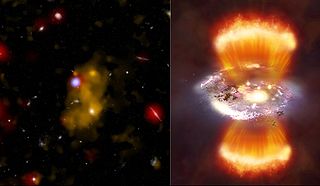
A Lyman-alpha emitter (LAE) is a type of distant galaxy that emits Lyman-alpha radiation from neutral hydrogen.
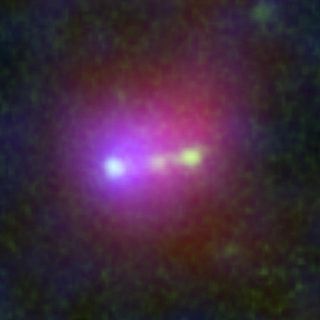
Himiko is a large gas cloud found at redshift of z=6.6 that predates similar Lyman-alpha blobs. At the time of its discovery in 2009, researchers said it "may represent the most massive object ever discovered in the early universe". It is located in Cetus at redshift z=6.595, about 12.9 billion light-years from Earth, or about 75×1021 miles (122×1021 kilometers).

GRB 090423 was a gamma-ray burst (GRB) detected by the Swift Gamma-Ray Burst Mission on April 23, 2009, at 07:55:19 UTC whose afterglow was detected in the infrared and enabled astronomers to determine that its redshift is z = 8.2, making it one of the most distant objects detected at that time with a spectroscopic redshift.

Lyman-break galaxies are star-forming galaxies at high redshift that are selected using the differing appearance of the galaxy in several imaging filters due to the position of the Lyman limit. The technique has primarily been used to select galaxies at redshifts of z = 3–4 using ultraviolet and optical filters, but progress in ultraviolet astronomy and in infrared astronomy has allowed the use of this technique at lower and higher redshifts using ultraviolet and near-infrared filters.

UDFy-38135539 is the Hubble Ultra Deep Field (UDF) identifier for a galaxy which was calculated as of October 2010 to have a light travel time of 13.1 billion years with a present proper distance of around 30 billion light-years.

The SSA22 Protocluster, also known as EQ J221734.0+001701, is a galaxy protocluster located at z=3.1 in the SSA 22 region. It is located at 22h 17m 34.0s +00° 17′ 01″ and was originally discovered in 1998.
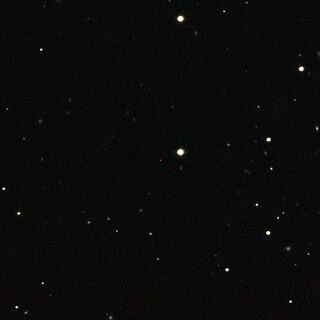
ULAS J1120+0641 was the most distant known quasar when discovered in 2011, surpassed in 2017 by ULAS J1342+0928. ULAS J1120+0641 was the first quasar discovered beyond a redshift of z = 7. Its discovery was reported in June 2011.

Green bean galaxies (GBGs) are very rare astronomical objects that are thought to be quasar ionization echos. They were discovered by Mischa Schirmer and colleagues R. Diaz, K. Holhjem, N.A. Levenson, and C. Winge. The authors report the discovery of a sample of Seyfert-2 galaxies with ultra-luminous galaxy-wide narrow-line regions (NLRs) at redshifts z=0.2-0.6.
The photon underproduction crisis is a cosmological discussion concerning the purported deficit between observed photons and predicted photons.

Haro 11 (H11) is a small galaxy at a distance of 300,000,000 light-years (redshift z=0.020598). It is situated in the southern constellation of Sculptor. Visually, it appears to be an irregular galaxy, as the ESO image to the right shows. H11 is named after Guillermo Haro, a Mexican astronomer who first included it in a study published in 1956 about blue galaxies. H11 is a starburst galaxy that has 'super star clusters' within it and is one of nine galaxies in the local universe known to emit Lyman continuum photons (LyC).
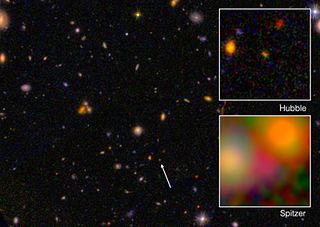
EGSY8p7 (EGSY-2008532660) is a distant galaxy in the constellation of Boötes, with a spectroscopic redshift of z = 8.68, a light travel distance of 13.2 billion light-years from Earth. Therefore, at an age of 13.2 billion years, it is observed as it existed 570 million years after the Big Bang, which occurred 13.8 billion years ago, using the W. M. Keck Observatory. In July 2015, EGSY8p7 was announced as the oldest and most-distant known object, surpassing the previous record holder, EGS-zs8-1, which was determined in May 2015 as the oldest and most distant object. In March 2016, Pascal Oesch, one of the discoverers of EGSY8p7, announced the discovery of GN-z11, an older and more distant galaxy.

TON 618 is a hyperluminous, broad-absorption-line, radio-loud quasar and Lyman-alpha blob located near the border of the constellations Canes Venatici and Coma Berenices, with the projected comoving distance of approximately 18.2 billion light-years from Earth. It possesses one of the most massive black holes ever found, at 40.7 billion M☉.
Q2343-BX418 is a young, low-metallicity dwarf galaxy located about 10 billion light years away from Earth. It has a redshift of 2.3052, and a stellar mass of 500 million solar masses.

UM 287 known as PHL 868 and LBQS 0049+0045, is a quasar located in the Cetus constellation. Its redshift is 2.267134 estimating the object to be located 10.9 billion light-years away from Earth.
